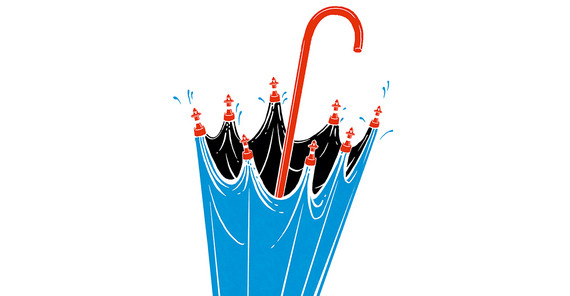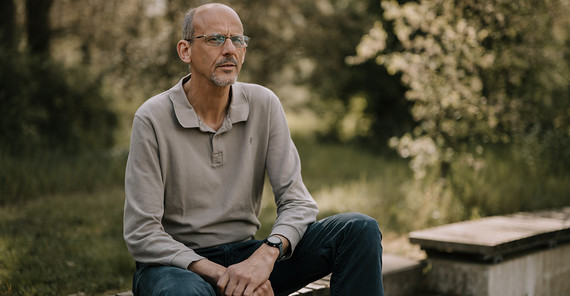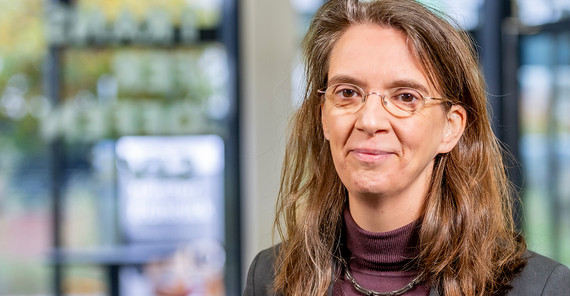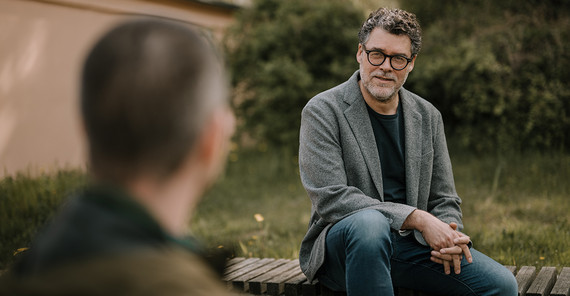Why do we find it so hard to deal with extreme weather events?
Thieken: Because – as the name suggests – they are extreme and usually occur unexpectedly at exceptionally long intervals. Societies can adapt well to risks when they are associated with frequent and repeated events. But risk governance fails in the face of infrequent events, which, on average, occur less than once in 100 years. These extremes are often missing from the series of measurements on which we base our normal planning. Thus, our picture of extreme events is incomplete, leading to a chain of consequences.
Van der Beek: The main problem is that our measurement series are too short to accurately describe and estimate the variability of what can occur, both when there is too little water and when there is an extremely large amount of water. In addition, certain data have not yet been incorporated, such as geological time series of sediments to understand historical floods. That has an impact on risk assessment. The strength of extreme events, which are now also increasingly changing due to climate change, takes us repeatedly by surprise.
Wagener: The research community has yet to acquire the interdisciplinary knowledge and modeling capability to holistically quantify the complex risks of future water extremes. This includes interactions and feedback with as well as within society. This scientific gap has so far prevented us from building the much-needed framework that could provide the insights that enable effective and robust decision making for resilient societies.
Can you give an example of this? Why do extreme events confound the findings?
Thieken: Let’s take dikes: These are built to protect the areas behind them and to allow certain uses, such as agriculture. Dikes limit recurring floods and protect the settlements behind them, which therefore grow because people feel safe. If a historic flooding suddenly occurs and destroys the dikes, not only the protection from the water fails, but the effects are more drastic than they would have been without the dikes. In the literature, this is called a paradox because the protection provided by the dikes was supposed to prevent the damage, but now it significantly increases the impact of the destruction. That is the pitfall with technical or structural measures such as dikes. They stand their test within a certain framework for which they are designed. If that is exceeded, you would need a second plan. In the Netherlands, for example, there is a “polder concept” so that if a dike breaks, the water cannot spread unhindered but remains within a certain ring.
Wagener: Reservoirs or dams, which we build to bridge dry periods, can lead to paradoxical behavior too. Reservoirs tend to increase water use. If droughts occur more often due to climate change, the water capacities will be far from sufficient to supply the adjacent areas with water. The consequences of droughts will be more calamitous for people than they would have been before the reservoir was build. This cannot be prevented entirely, but the risks can be minimized when findings of such side effects are included.
Where does the University of Potsdam already have profound knowledge that can be developed?
Thieken: In Potsdam, we look back on a more than 150-year-old research tradition in the geosciences. This has given rise, for example, to the German Research Centre for Geosciences (GFZ) and the Potsdam Institute for Climate Impact Research (PIK). In the midst of all this is the University of Potsdam. Although with its 30 years it is much younger, it has always focused on natural hazards and interdisciplinary networking in the geosciences and environmental sciences. Just think of the “Geo.X” platform for geoscientific research in Berlin and Potsdam.
To emphasize this prioritization, professorships were created at the University of Potsdam ten years ago to study both natural hazard processes such as landslides or floods and to look at societal risks. In other words, we have been investigating for a long time the societal impacts caused by natural hazards. How can these risks be minimized? And that, of course, is a good bridging function, on the one hand to other natural science chairs of hydrology, geology, and mathematics and on the other hand to the administrative and political sciences, which analyze the consequences of climate change for decision-makers in society. With the application for an excellence cluster, we are creating an excellent foundation to advance this interdisciplinary expertise.
Wagener: The University of Potsdam is at the center of a thriving, inspiring, and growing research environment with a particular focus on risks from natural hazards and water extremes. Leading researchers are already working together here to understand the system Earth. Through joint professorships with said institutes – PIK, GFZ, and also the Center for Environmental Research (UFZ) in Leipzig and the Institute for Agricultural Engineering and Bioeconomy in Bornim (ATB) – the University of Potsdam has established a research community on which we are building now. Our cluster integrates internationally leading researchers such as the jointly appointed professors Johan Rockström (PIK) and Bruno Merz (GFZ) and exceptional researchers who are still at the beginning of their careers, such as Prof. Eva Eibl (University of Potsdam) and Prof. Jakob Zscheischler (UFZ). We also bring together researchers from all disciplines to which water extremes are relevant. It is very important that we link this natural science research much more strongly with the social sciences and involve experts from the University of Potsdam such as Prof. Sabine Kunstmann and Prof. Julia Fleischer.
Van der Beek: Remote sensing is one of the big strengths in Potsdam, for example with Prof. Dr. Bodo Bookhagen at the University of Potsdam and Prof. Herold at the GFZ as a professor affiliated with the university. I think what makes Potsdam special is the very strong connection between the university and the non-university institutions. There are many joint appointments, and collaborations are well coordinated, as can be seen not least in the many interdisciplinary doctoral projects. A unique practice, well established and with potential that is far from exhausted. Nowhere else is there such a strong regional concentration of competence and methodological diversity. In addition, there are joint master’s and doctoral programs and a wide range of research projects that already link the university with its non-university partners. Developing these existing synergies into an excellence cluster will enable us to use the current momentum to create an environment for world-leading research, education, and knowledge exchange.
How can the strengths of the Potsdam research area be pooled?
Wagener: The University of Potsdam and our participating partners are already scientific leaders in the primary areas of the proposal: For example, our researchers advance large-scale monitoring of the Earth system by conducting and developing innovative ground- and satellite-based measurements. We introduced seismic monitoring to track the evolution of mass erosion and flood events. We were the first to install a cosmic ray neutron measurement system on Deutsche Bahn trains to quantify soil moisture dynamics on an unprecedented scale. Our progress in observations is not limited to physical processes. We have also collected and analyzed extensive social science datasets to decipher the dynamics and heterogeneity of human vulnerability and behavior in response to water extremes.
Van der Beek: The researchers of the University of Potsdam, PIK, GFZ, UFZ, and ATB, who are involved in our proposal, have gained extensive new insights into hazard processes caused by water extremes and how they are influenced by climate change. For example, we have been able to show that extreme floods are influenced by processes that significantly differ from those driving more frequent floods. This has crucial implications for their prediction and management. We examine how climate change affects the frequency of floods, landslides, droughts, and forest fires. And most importantly, we study the interconnections of these extremes, as they often have much greater impacts when combined than when they occur alone.
Will science be able to prevent catastrophes, such in the Ahr Valley, in the future?
Thieken: It cannot completely prevent them, but it can better assess risks and damages and initiate measures in good time to reduce damage. Experts in the Ahr Valley, for example, are already systematically looking for retention areas in which any water masses that occur can be temporarily stored. This is definitely important to cut the peak so that not all of the precipitation from heavy rain gets directly into the river. Building dikes is out of the question in a narrow valley. During the flood in the Eifel, we also saw that cars, tree trunks, debris, and sediment washed along and clogged the bridges. At some point, the water pressure was so strong that a wave broke through, which then in turn raged even more severely and tore down the bridges. This means that good concepts are needed for such neuralgic points during reconstruction. Bridges should be more open and larger to prevent these blockages. Extreme events are marked on maps to designate high-risk areas. These regions need to be evacuated earlier to at least minimize the number of casualties, and also to keep people’s exposure to flood waters low. Many experienced the flood firsthand during the night – a traumatic event that comes with a sense of being out of control. This calls for good warning systems, functioning disaster control, and ideas to make reconstruction relatively quick and uncomplicated.
Wagener: Potsdam already has a wide range of expertise in this area, too. We have developed empirically derived flood damage models, which consider influencing factors such as physical processes but also human behavior. This makes assessments more precise and predictions of flood consequences more realistic. We are among the first to study and quantify interactions in international multi-level risk governance, demonstrating, for example, the important influence of informal actors in shaping climate policy. We compiled the first global dataset to show that we are learning insufficiently from repeated droughts and floods. While this is a negative result for now, it also shows that we can do much better in the future if we improve the scientific basis of our decisions.
Van der Beek: This is precisely where we increasingly need the social sciences. Society is not a passive recipient of risks. Our behavior actually increases risk to some extent, for example by living in hazard zones. We need to better understand the dynamics between extremes and society. In addition, communication and transfer of science-based facts are becoming more relevant for decision-makers and opinion formation in society. In the future, policymakers will have to provide information about hazards with large uncertainties. We cannot prevent extreme precipitation events, but we can prevent them from impacting our lives.
Your vision: to understand and simulate water extremes and to respond to them with guidelines for action. A very large undertaking that aims for the stars?
Van der Beek: We are well positioned to start here with larger visions and projects. Cluster research allows us to work in larger groups to make even more progress in the long term than anything we have done so far. To protect ourselves from extreme events, we urgently need to advance our models and develop our research methods. Of course, it is also important to slow down climate change itself. But at the same time, we need to better understand these extremes so that we can prepare ourselves against them.
Thieken: And the susceptibility to damage is becoming a central issue. Here we want to collect data in a very targeted way. So-called “longitudinal studies” are important, in which individuals are accompanied over a longer period of time in order to collect longitudinal data on their precautionary behavior, perception of hazards, protective options, resources, etc. Based on the results, we can then develop significantly better models, so that the predictions are significantly optimized.
What is new and how do you extend existing approaches?
Thieken: We bring together three major fields of research: natural hazards/processes, their interaction with society, and integrated models for visualization. In this way, scientifically based findings are processed in a nuanced and comprehensible way. On such a basis, political decision-makers can take into account different scenarios. We plan to use virtual reality tools to support such decision-making processes by making the scenarios comprehensible. We ventured the attempt to translate basic research into application and transfer. There can be no greater added value, don’t you think? Take the Harding Center, for example, which is famous for its risk communication. Risks are based on probabilities, but many decision-makers struggle to interpret appropriate models or studies correctly. We want to use the valuable work of the Harding Center to better communicate our results so that people are able to understand and interpret these probabilities, too.
What will be the benefits of an excellence cluster for the University of Potsdam?
Wagener: A cluster in this area would be a great achievement. For Potsdam, Brandenburg, and beyond. There is a huge need for a better scientific basis for decision-making by cities, municipalities, states, the federal government, and also international organizations like the World Bank. It would be the logical continuation of the work we are doing in Potsdam. In terms of content and collaboration, I expect a real push that will intensify and expand the interdisciplinary cooperation of mathematics, physics, geosciences, environmental sciences, but also political and administrative sciences. We expect that an excellence cluster on water extremes will lead to ground-breaking progress in the next decade. We aim for an integrated description of risk based on a gradual change of our quantitative understanding of rare water extremes and their interaction with society (human behavior and management). An integrated science-based approach would enable considerable progress along the entire risk chain in the integrated human-earth system: from understanding to prediction to management.
The cluster could help train a new generation of researchers?
Van der Beek: It cannot be stressed enough what impact a cluster would have on the academic community in Potsdam. It would decisively promote the development of the University of Potsdam into the research university we want it to be. Such a cluster would create a unique, internationally leading center of excellence for water extremes and their risks. The cluster would enable the training of a new generation of researchers and the development of a joint scientific culture across academic disciplines, which is essential for understanding and addressing the complexity of water extremes.
The Researchers
Prof. Dr. Annegret Thieken studied geo-ecology at Technische Universität Braunschweig and environmental sciences at the University of Amsterdam. Since 2011, she has been Professor of Geography and Disaster Risk Research at the University of Potsdam.
Mail: annegret.thiekenuuni-potsdampde
Prof. Dr. Peter van der Beek studied geology at Vrije Universiteit Amsterdam. For over 20 years, he was a researcher at the Université Joseph Fourier in Grenoble, France. Since 2020, he has been Professor of General Geology at the University of Potsdam.
Mail: vanderbeekuuni-potsdampde
Prof. Thorsten Wagener, Ph.D. studied civil engineering at the University of Siegen, TU Delft (Netherlands) and Imperial College London (UK). He has held professorships at Pennsylvania State University (USA) and the University of Bristol (UK). Since January 2021, he has been the Alexander von Humboldt Professor for Hydrologic Systems at the University of Potsdam.
Mail: thorsten.wageneruuni-potsdampde
This text appears in the university magazine Portal Wissen - Zwei 2023 „Exzellenz“ (PDF).




